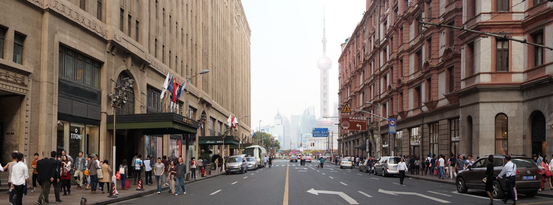Urban Retrofits in Shanghai Inspire Green, People-First Development Across China
Shanghai celebrated a major achievement for green urban development and people-friendly mobility in September 2020 as the iconic Nanjing East Road became fully pedestrianized. After more than four years of debate since Energy Foundation China (EF China) and our grantees first suggested the idea, people can now enjoy a protected walk between the two landmarks on China’s premier shopping street, Nanjing Road, and the historic Bund. The pedestrianization of the road—emblematic of Shanghai’s transition from car-oriented to people-oriented development—is one of several high-profile projects in the city that affirms the urbanization principles we have been working on in recent years.


Nanjing East Road before (above) and after (below) the retrofit
In 2015, EF China and grantees Gehl Architects and the China Sustainable Transportation Center (CSTC) completed the Liveability and Green Mobility Strategy with the local district government. The strategy highlighted the potential for turning the car-dominated Nanjing East Road into a people-first public space. It was a bold proposal to make changes to “China’s first commercial street”; the coordination among stakeholders would be complex and difficult, and resistance to removing car traffic from a major road would be nontrivial. Our thorough analysis persuaded decision-makers and the public to make the right—and obvious—choice. For example, we found that while more than 90 percent of all travel on Nanjing East Road was from pedestrians, more than 80 percent of the space was given to cars. After the pedestrianization idea was adopted, the physical retrofit began. As Nanjing East Road has re-opened, new shops for both international and Shanghai traditional brands have settled in, finding newly increased commercial value of the road.
This is just one in a series of EF China’s urban retrofit success stories in Shanghai. People-oriented urban retrofits boost green mobility, reinvigorate urban life, and vitalize local economies—all of which are crucial to helping China realize its newly announced carbon neutrality goal. China is now standing at a crossroads, shifting from “high quantity” to “high quality” development. This shift will accelerate the amount of urban retrofitting in China—a market that is around a trillion RMB per year already, and growing rapidly. Our recently developed Urbanization Task Force Strategy features urban retrofits as one of the key priority interventions in the coming five years. Our success in Shanghai—which we will promote throughout China and work to integrate into both local and national policies—highlights how well-designed urban retrofit projects have huge potential to support a city’s ambition to become greener and decarbonized.
Shanghai Street Design Guidelines
In 2016, we supported the Shanghai Street Design Guidelines, which won two national prizes: the “Best Planning and Design Document” and the “Best Engineering Design Document” in China. The Guidelines changed people’s thinking of the street as a mobility corridor to thinking of the street as a foundation for people’s health; for cultural, social, and economic exchanges; and for sustainable and livable lifestyles. They already have inspired 20 other major Chinese cities to develop similar plans, with more and more cities now following suit. In this way, the Guidelines are scaling up physical changes throughout urban China.




